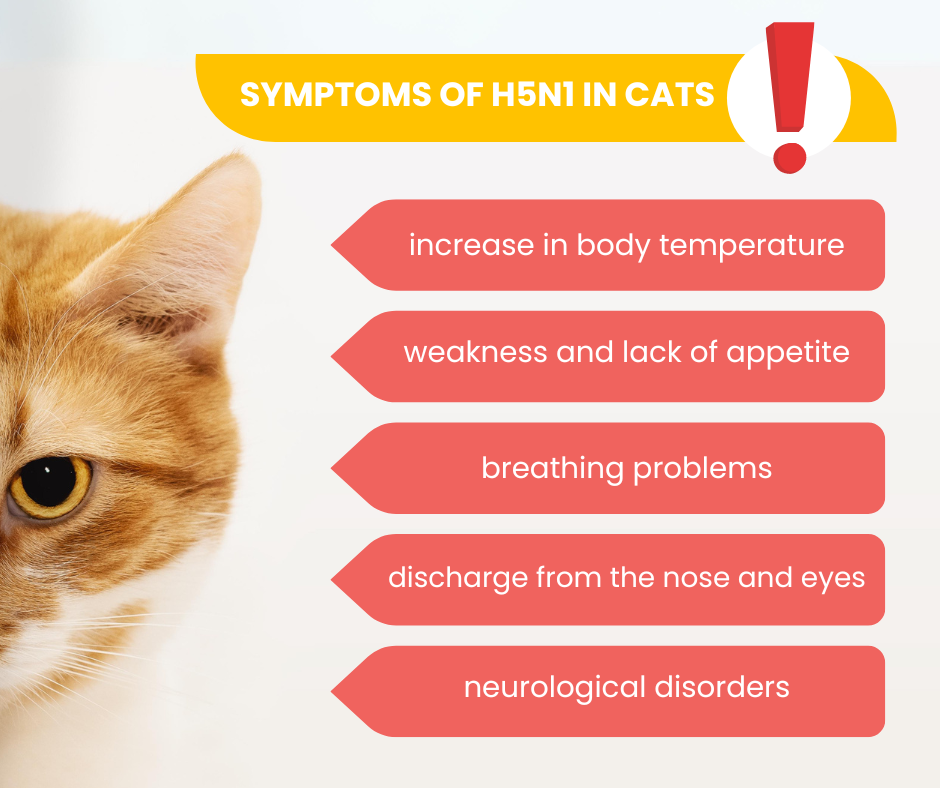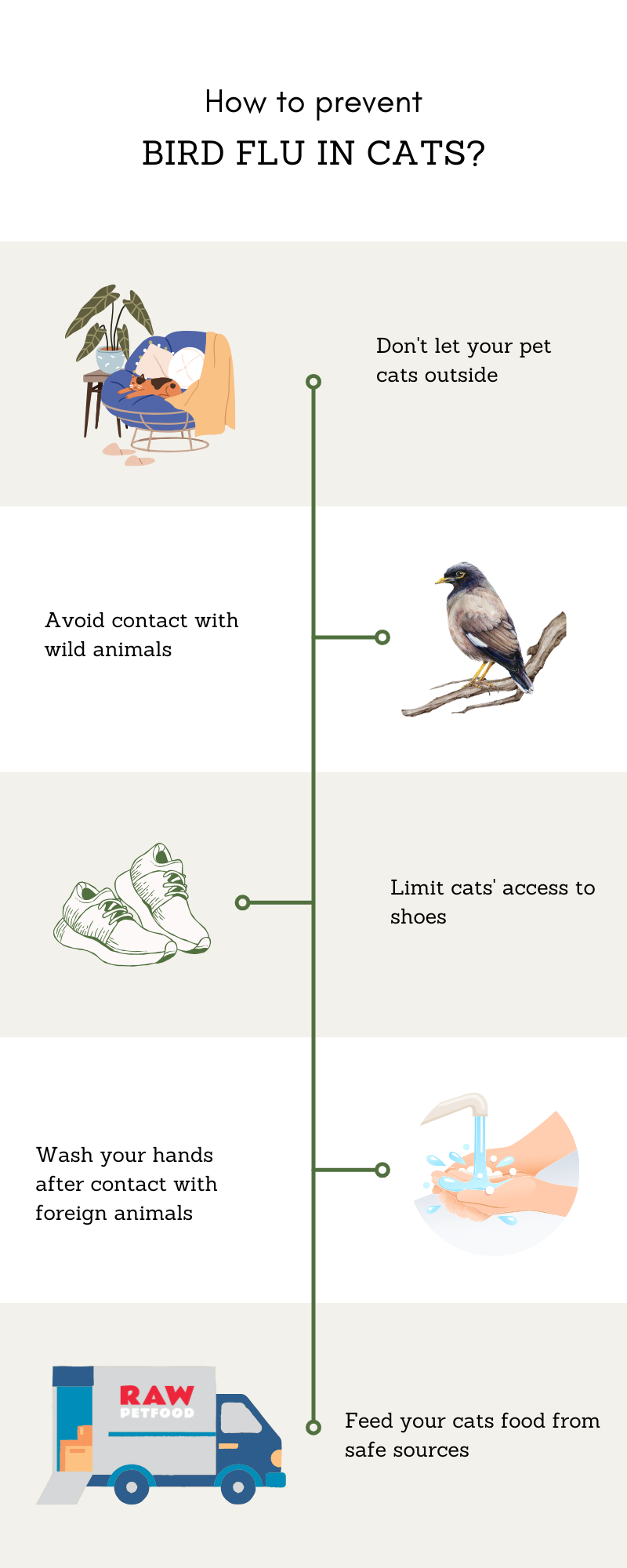Bird flu in cats and day-old chicks

Avian influenza is a viral infectious disease that primarily affects birds, but in some cases also spreads to other animal species. In 2023, the H5N1 virus became a widely discussed topic among cat owners. In 2024, concerns about the possibility of the disease occurring in our pets, especially those fed poultry in the form of barf or whole prey diet (whole prey what is it), still persist. At Raw PetFood, questions are also directed about whether our day-old chickens are safe for cats and what procedures ensure that this is the case?
In the article below, we reveal our cards to show how at the Raw PetFood whole prey store we ensure to completely eliminate the risk of selling infected poultry. It presents information about breeding and production processes, our supply chain, and safety procedures that ensure our frozen chicks are a safe food for cats.
Indeed, in June last year, the Chief Veterinary Officer confirmed cases of cat infection with the highly pathogenic avian influenza virus. Among the 33 samples tested from various cities (Gdańsk, Gdynia, Poznań, Lublin, Pruszcz Gdański, Nowy Dwór Mazowiecki, Bydgoszcz, Wrocław, and the vicinity of Zamość), 15 of them tested positive, confirming the presence of the H5N1 virus in cats1. To this day it is unknown what was the source of the virus.
Cases of Avian Flu in Cats: Symptoms, Risk, and Spread

The spread of the avian flu virus in the cat population can occur in various ways. The most common include direct contact with infected birds or their droppings, access to other infected animals, and access to surfaces or objects contaminated by them. The virus demonstrates a high ability to survive in various environments, further increasing the risk of infection.
Highly pathogenic avian influenza in cats can manifest in various ways, which can be difficult to identify immediately.
The most commonly observed symptoms include:
- Sudden increase in body temperature,
- Significant weakness and loss of appetite,
- Breathing problems,
- Discharge from the nose and eyes,
- In some cases, neurological disorders.
Given that these symptoms can resemble other, less serious illnesses, a veterinary consultation is recommended in case of any doubts.
At the same time, the Chief Veterinary Officer issued recommendations for preventing infections of domestic cats with avian flu2:
- Keeping cats indoors as the most effective way to limit their access to birds and surfaces exposed to the virus,
- Avoiding human contact with wild animals, especially birds, which are the main source of the highly pathogenic H5N1 flu virus,
- Limited contact of cats with external footwear to prevent the transmission of the virus from outside to home,
- Practicing hygiene by humans, including washing hands after contact with animals outside the home,
- Feeding cats food from safe sources to avoid potential sources of infection.
The whole prey Raw PetFood store, as a provider of frozen cat food, is concerned with the last point, and we approach it with due seriousness. The process of preventing the sale of day-old chicks infected with the virus begins already at the poultry breeding stage, where bird health control is a priority. Then, it is important for us to adhere to rigorous standards during the transport of eggs and in the incubation process. In our poultry hatching plant, we monitor the health of both hens and roosters, and then apply freezing and storage procedures that prevent the sale of chicks in case of detection of a disease outbreak in the parent flock.

Avian Flu in Poland — Regulations
We should start by saying that in Poland there are regulations and rules preventing the sale of infected poultry — and we strictly adhere to these rules, being under the supervision of the Chief Veterinary Inspectorate.
The regulations concerning the management of highly pathogenic avian flu outbreaks on poultry farms in Poland focus mainly on biosecurity, monitoring, and disease control. According to the regulations, breeders are obliged to implement a range of preventive measures, including, among others, isolation of flocks, regular removal of dead poultry, keeping a record of transport means, and a registry of entries into poultry rooms.
On poultry farms in Poland, there is also an obligation to report to the authorities cases of increased mortality in poultry. According to the biosecurity regulations, which came into effect on May 6, 20224, poultry breeders are obliged to inform the Veterinary Inspection of the occurrence of certain disease symptoms in poultry. These symptoms include increased mortality, decreased feed and water intake, nervous symptoms, dyspnea, cyanosis and hemorrhages, diarrhea, and a sudden drop in egg production.
In the biosecurity plan, which must be prepared on farms keeping more than 350 poultry, it is necessary to include “clean” and “dirty” zones, as well as cleaning and disinfection procedures, employee hygiene, and pest control. Moreover, in case of a threat, farms conducting supervised activities must be equipped with disinfectant mats and apply appropriate biological safety measures.
Avian Flu in Poland — Procedures
The procedure in case of suspicion of highly pathogenic avian flu on a poultry farm in Poland is detailed and goes as follows:
- Immediately upon noticing symptoms of H5N1 virus infection, the breeder is obliged to report the suspicion of highly pathogenic avian flu to the district veterinary officer or the nearest veterinary service provider.
- Until the arrival of the veterinary officer, the breeder should isolate and guard all birds on the farm and refrain from transporting, removing, and selling products from the farm.
- The official veterinary officer assesses the situation on site and takes samples for laboratory tests.
- If the test results confirm the presence of the virus, procedures for controlling the outbreak are implemented, which may include, among other things, the culling of flocks.
Breeders who do not report suspected infection are not entitled to compensation — in the case of highly pathogenic H5N1 flu, which has a mortality rate reaching 100%, this is a risk that no poultry breeder can afford.
Information about the occurrence of avian flu on farms in Poland is public and published by relevant institutions, such as the Chief Veterinary Inspectorate. Public disclosure of this information is key to taking appropriate preventive actions and responding to threats related to public health and animal breeding, so there is no possibility of concealing it.
How Avian Flu Spreads
In the case of infection with the highly pathogenic avian influenza virus, symptoms appear suddenly (within 3 to 5 days, up to a week), and mortality can approach even 100% within 48 hours3. Avian flu viruses can be transmitted both horizontally (from bird to bird) and vertically (from mother to eggs), though vertical transmission is less common. In the case of avian flu, the most typical scenario is where the virus is transmitted within a flock through direct contact between birds or through a contaminated environment.
Not every egg from an infected hen will inevitably contain the virus. If the virus enters the egg, there is a risk that the chicks will be infected during incubation — but at Raw PetFood, we have appropriate procedures in place for such an eventuality.
Production Process and Supply Chain at Raw PetFood
Our experience in poultry farming, knowledge of legal regulations, and understanding of the risks associated with avian flu allow us to provide customers with cat food that is 100% safe. To understand the certainty that no chicks infected with bird flu will be sold in our store, one must follow the production process of this type of cat food.
The process of producing frozen chicks begins on the farm, where breeding hens and roosters are raised. The birds lay fertilized eggs, which is the first step in the breeding process. These eggs are then transported by a special vehicle to the poultry hatchery. In the hatchery, the eggs are placed in incubators, where after three weeks, chicks hatch from the eggs. This process is closely monitored to ensure optimal conditions for the development of the chicks.
If an infection with the highly pathogenic avian flu dangerous to cats occurred in the parent flock, in practice, the fertilized eggs might not even reach our incubators. Remember that symptoms of the disease in birds are sudden (usually occurring within 3 to 5 days, up to a week), and mortality can reach even 100% within 48 hours of the onset of symptoms.
However, even if we place the eggs in the incubators during this time, before the chicks hatch, another three weeks pass, during which news of the outbreak of avian flu would not only be passed on to us but also made public. Eggs from a flock affected by the avian flu virus would be disposed of in such a case, and they would not hatch.
Before the Chicks Are Sold
After the chicks hatch, they are selected. Females are usually intended for further rearing, while males are humanely euthanized and used as food for animals, including cats. The chicks are then cooled and shock frozen, which is the next step in ensuring their safety as food. At Raw PetFood, we practice the principle of storing each batch in the freezer for at least two weeks, which allows for the identification and elimination of potential health hazards, including avian flu.
The initial three weeks of incubation is enough time to identify the disease in the parent flock. This already reduces the risk of selling sick chickens in our store practically to zero. However, even if it turned out that infected eggs were hatched in our facility, the time of the remaining procedures and the additional period of storing the chicks in the freezer gives us confidence that the disease would be detected in the females sold for rearing. In such a case, that batch of food would never be sold in our store, but would be disposed of,
What Makes Our Day-Old Chicks Safe for Cats?
In conclusion — when it comes to day-old chicks, price should never be the determinant of where we source food for our cat. Choosing a proven store that sells high-quality products is nothing less than an expression of care for the health and safety of cats. Frozen day-old chicks can be completely safe food only if they come from reliable, experienced industry suppliers whose procedures prevent the sale of day-old chickens from a flock in which symptoms of highly pathogenic avian influenza H5N1 have occurred.
Thanks to our many years of experience in the industry and strict control procedures, we can ensure that our products are free from avian flu and other threats. In our facility, we take care of every stage of the production process. At the breeding farms, hens and roosters are closely monitored for health. Fertilized eggs are transported to our poultry hatchery with all precautions, and then incubated for about three weeks. After hatching, the cockerels are humanely euthanized and frozen for cat food. This process includes shock freezing, which further ensures the safety of the product. We also practice the principle of storing each batch in the freezer for at least two weeks, which allows for the identification and elimination of potential health hazards, including avian flu.
Sources:
Recommended

Day-old chicks (chickens) 10kg

Day-old chicks (chickens) 1kg

Day-old chicks (chickens) 1kg x 5

